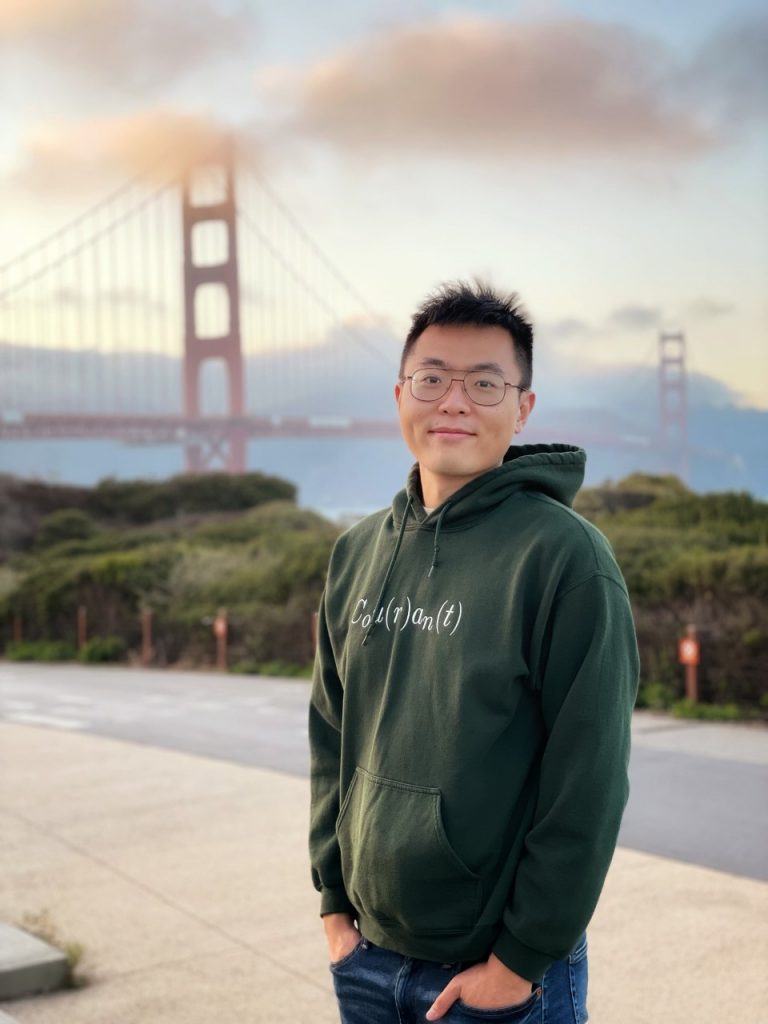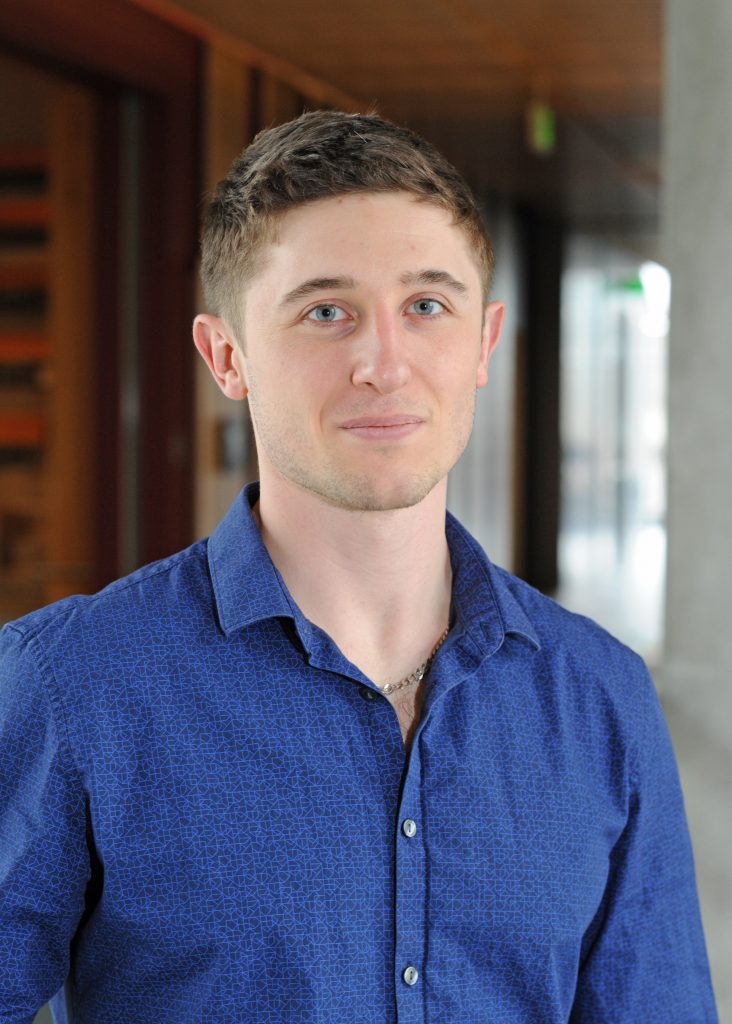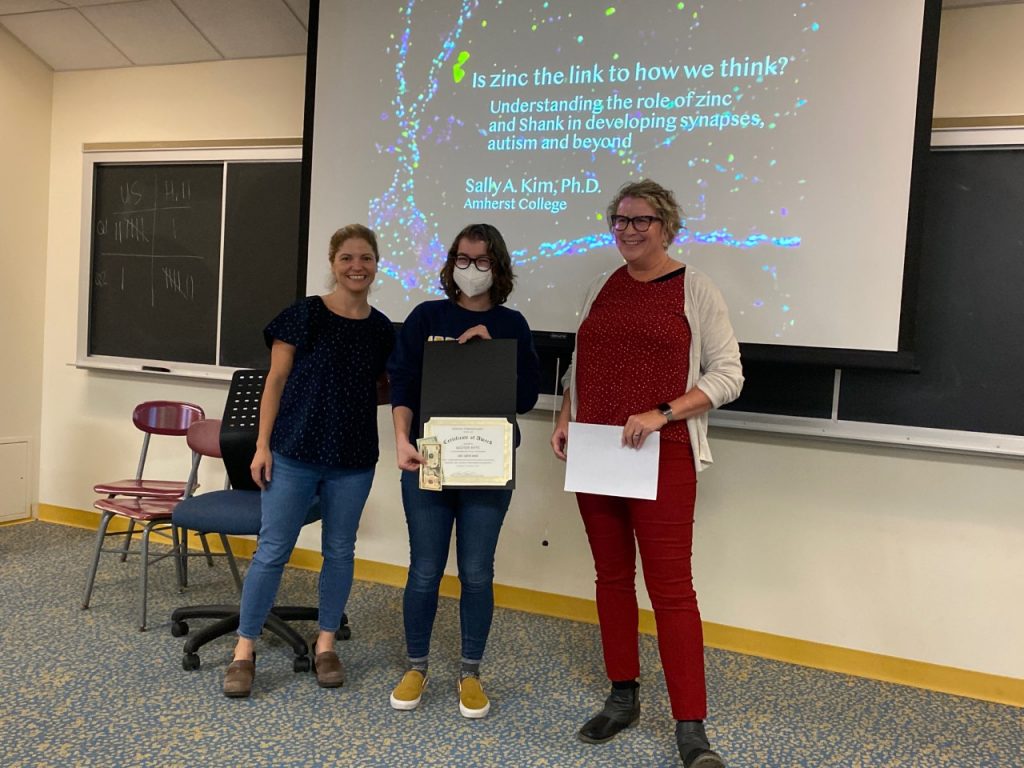
UMass neuroscientists are presenting their research at the Society for Neuroscience Conference in Washington, DC. Here is a list of titles and authors for those presentations. Click on the number to read the abstract.
Continue reading

UMass neuroscientists are presenting their research at the Society for Neuroscience Conference in Washington, DC. Here is a list of titles and authors for those presentations. Click on the number to read the abstract.
Continue reading
This summer’s featured Researcher in Dr. ChangHui Pak, who is an Assistant Professor in the Department of Biochemistry and Molecular Biology. She has joined UMass in 2018 after completing postdoctoral research in the lab of Nobel laureate, Thomas Sudhof. The Pak Lab studies the molecular signaling pathways involved in synapse formation. One of the techniques that they use is the creation of brain organoids from induced Pluripotent Stem Cells (iPSCs). She was recently senior author on a Book Chapter titled, “Method to Generate Dorsal Forebrain Brain Organoids from Human Pluripotent Stem Cells” published in Stem Cell-Based Neural Model Systems for Brain Disorders.
Here’s what else is new for ‘ ”University of Massachusetts” AND Amherst AND neuroscience’ in PubMed. These publications appeared online from May to August. They are just a fraction of the neuroscience research that occurs on campus. You can click on the PubMed ID to find the publication.
Continue reading
This month’s featured researcher is Alexander Suvorov, who is an Associate Professor of Environmental Health Sciences and the Graduate Program Director of Environmental Health Sciences in the School of Public Health and Health Sciences. Alexander is also an associate member of the Neuroscience & Behavior Graduate program. His lab studies environmental endocrine disruptors that have the ability to interfere with endogenous hormonal signaling. Exposure to these substances during critical periods of prenatal or neonatal life may cause permanent reprogramming of target tissues, likely epigenetic in nature, which often do not present immediate phenotypes but can ultimately lead to adulthood onset diseases. He is a co-author on a review article that appeared recently in Human Reproduction Update titled, “Age-associated epigenetic changes in mammalian sperm: implications for offspring health and development“. This work dovetails with a recent NSB seminar by Bianca Marlin on transgenerational transmission of information. It also resonates with the theme of the Neuroscience of Aging for the May 3st Interdisciplinary Neurosciences Conference
Here’s what else is new for ‘ ”University of Massachusetts” AND Amherst AND neuroscience’ in PubMed. These publications appeared online in April. They are just a fraction of the neuroscience research that occurs on campus. You can click on the PubMed ID to find the publication.
Continue reading
Hui Wei is a third-year Computer Science PhD student in the Manning College of Information and Computer Sciences, where he works under supervision of Prof. Benjamin Marlin in the Robust and Efficient Machine Learning (REML) lab. His research interest is applying machine learning to improving human health. Currently, he is working on machine learning for mobile health and the missing value problem in the time series data. Previously, Hui was working on evaluating the clinical diagnostic accuracy of dementia subtypes, with Prof. Narges Razavian in the Department of Population Health, NYU Grossman School of Medicine.
His recent publication in Frontiers in Aging Neuroscience compares the diagnosis in the clinic with autopsy results on Alzheimer’s disease, Lewy body disease and their combination with respect to different Clinical Dementia Rating stages. They demonstrate the diagnosis of these dementia subtypes is inaccurate and also suffers from the significant disparity in race and sex.

This month’s featured researcher is Dr. Lucy Xiaolu Wang. Lucy is an Assistant Professor in the Department of Resource Economics in the College of Social and Behavioral Sciences. She is also a Faculty Research Fellow at the Max Planck Institute for Innovation and Competition in Germany and a Faculty Associate at the Canadian Centre for Health Economics. In March, she and a collaborator published an article in The Conversation, describing her economic analysis published in PLoSOne of the Human Brain Project (HBP), a controversial $1.3 billlion European initiative that was originally led by Henry Markham. They examined the user interactions on the HBP public-access online forum to determine the value of online collaborative platforms.
Here’s what else is new for ‘ ”University of Massachusetts” AND Amherst AND neuroscience’ in PubMed. These publications appeared online in March. They are just a fraction of the neuroscience research that occurs on campus. You can click on the PubMed ID to find the publication.
Continue reading
Yesha Patel is a senior Biochemistry & Molecular Biology and Economics dual degree undergraduate student as well as a member of the Commonwealth Honors College at the University of Massachusetts Amherst. On campus, Yesha has been a TA in the Biology department for the last two years and is in the Minutemen Equity Fund. Since she was a sophomore, Yesha has been working summers in Dr. Ella Zeldich’s lab at Boston University’s School of Medicine. She is an author on a paper that was recently published in the International Journal of Molecular Sciences, titled “Extracellular Vesicle Treatment Alleviates Neurodevelopmental and Neurodegenerative Pathology in Cortical Spheroid Model of Down Syndrome“
Continue reading
April 1, 2023 – UMass Neuroscience alum and McDonald’s Genius Award Winner, George Santos will be delivering the annual Laurel and Hardy Lecture in McGuirk Stadium. The title of his talk will be “The neural basis of confabulation”. Dr. Santos is well known for his discovery of the polio vaccine, his invention of the pipette, and his sequencing of the human proteome.
His more recent work has shown how humans are susceptible to false beliefs if uttered by someone who really believes them. Santos will be giving his lecture while immersed in a tank of sharks and playing a fiddle.

This month’s featured researcher in Benjamin Marlin. Ben is an Associate Professor in the Manning College of Information and Computer Science, where he directs the Robust and Efficient Machine Learning (REML) group. Their work is s research is informed by real-world applications including clinical and mobile health. He was an author on paper that was published in January in the Journal Translational Behavioral Medicine, which describes some of the efforts of the Intensive Longitudinal Health Behaviors Network (ILHBN) to harmonize data collection across many different studies and data streams. Ben is also and Associate Director of the Massachusetts AI & Technology Center for Connected Care in Aging & Alzheimer’s Disease (MassAITC), which fosters the development of artificial intelligence for technology that support healthy aging at home for older adults and individuals with Alzheimer’s disease.
Here’s what else is new for ‘ ”University of Massachusetts” AND Amherst AND neuroscience’ in PubMed. These publications appeared online in January and February. They are just a fraction of the neuroscience research that occurs on campus. You can click on the PubMed ID to find the publication.
Continue reading
This month’s featured researcher is Dr. Gerald Downes, who is an Associate Professor in the Department of Biology. His lab uses zebrafish to understand how genes and neural networks in the brain and spinal cord control movement. They are also studying mechanisms that contribute to epilepsy with the hope of developing new therapeutics to treat these disorders. He and his PhD students are authors on a paper titled, “Amyotrophic Lateral Sclerosis-Associated Persistent Organic Pollutant cis-Chlordane Causes GABAA-Independent Toxicity to Motor Neurons, Providing Evidence toward an Environmental Component of Sporadic Amyotrophic Lateral Sclerosis“, which appeared this month in Chemical Neuroscience. This work was a collaboration with researchers at Wesleyan University.
Here’s what else is new for ‘ ”University of Massachusetts” AND Amherst AND neuroscience’ in PubMed. These publications appeared online in December. They are just a fraction of the neuroscience research that occurs on campus. You can click on the PubMed ID to find the publication.
Continue reading
This month’s featured research is Dr. Agnès Lacreuse. Agnès is a Professor in the Department Psychological & Brain Sciences. Her work is focused on age-related cognitive decline in a nonhuman primate with a short lifespan, the common marmoset (C. jacchus). Research from her lab recently appeared in the journal, Hormones and Behavior, showing that Letrozole, an aromatase inhibitor used in breast cancer treatment, alters gene expression in neurons of the hippocampus, a region of the brain involved with memory. The first author on this intriguing study was Melise Edwards, a PhD student in the Neuroscience and Behavior Graduate Program.
Here’s what else is new for ‘ ”University of Massachusetts” AND Amherst AND neuroscience’ in PubMed. These publications appeared online in November. They are just a fraction of the neuroscience research that occurs on campus. You can click on the PubMed ID to find the publication.
Continue reading
This month’s featured researcher is Dr. Rebecca Spencer. Bekki is a Professor in the Department of Psychological & Brain Sciences, where she runs the Somneurolab, dedicated to studying the neuroscience of sleep. She recently authored a publication in the Proceedings of the National Academy of Sciences, titled, “Contributions of memory and brain development to the bioregulation of naps and nap transitions in early childhood” in which she and her co-author, Tracy Riggins propose that nap transitions are more related to hippocampal development than age specifically. The story has received a lot of attention in the press, including the Boston Globe. You can read about it from the College of Natural Sciences.
Here’s what else is new for ‘ ”University of Massachusetts” AND Amherst AND neuroscience’ in PubMed. These publications appeared online in October. They are just a fraction of the neuroscience research that occurs on campus. You can click on the PubMed ID to find the publication.
Continue reading
UMass neuroscientists are presenting their research at the Society for Neuroscience Conference in San Diego. Here is a list of titles and authors for those presentations. Click on the number to read the abstract.
028.15. Synaptic protein levels and physiological activity in primary cortical neurons are influenced by time of day.
J. WANG, B. L. ROBERTS, I. N. KARATSOREOS;
031.02. Neuronal cell type mapping in the ring and rhinophore ganglia of a gastropod mollusc using single cell transcriptomics
M. D. RAMIREZ, T. N. BUI, P. S. KATZ
094.07. LC-NE regulation of goal directed behaviours
E. M. Vazey
Mini symposium talk
185.15. Quantitative assessments of neurodevelopmental disorders using deep learning and systems neuroscience techniques
K. DOCTOR, D. WU, A. PHADIS, J. NURNBERGER, Jr, M. PLAWECKI, J. V. JOSE
209.01. Structure and organization of the olfactory system in the mollusc Berghia stephanieae
C. C. TAIT, M. D. RAMIREZ, P. S. KATZ
209.02. A connectomics approach to an enigmatic ganglion in a gastropod mollusc
H. H. SANT, B. D. DRESCHER, Y. MEIROVITCH, R. SCHALEK, Y. WU, J. LICHTMAN, P. S. KATZ
224.02. Sex differences in adrenergic ?1 regulation of reinforcement behavior
E. M. RODBERG, S. Y. YU, E. M. VAZEY
291.10. Sensory Neuron Dysfunction in Orthotopic Mouse Models of Colon Cancer
C. GAFFNEY, M. BALOGH, J. ZHANG, N. KALAKUNTLA, N. T. NGUYEN, R. T. TRINH, C. AGUILAR, H. V. PHAM, B. MILUTINOVIC, J. M. NICHOLS, R. MAHALINGAM, A. J. SHEPHERD; MD Anderson
309.11. Circadian desynchronization-induced metabolic disorder is ameliorated by endocannabinoid receptor knockout, without change in feeding or activity
B. FALCY, G. L. PEARSON, T. L. LEISE, I. N. KARATSOREOS
386.06. The Chilean brush tailed mouse (Octodon degus): a diurnal precocial rodent as a new model to study visual receptive field properties of superior colliculus neurons.
N. I. MÁRQUEZ, P. FERNÁNDEZ?ABURTO, A. R. DEICHLER, I. PERALES, J.-C. LETELIER, G. J. MARÍN, J. MPODOZIS, S. L. PALLAS
445.08. Accelerated aging process with neurodegeneration in the cerebral cortex of cognitively impaired aged marmosets (Callithrix jacchus)
C. FREIRE-COBO, E. ROTHWELL, M. VARGHESE, W. G. M. JANSSEN, A. LACREUSE, P. R. HOF
468.17. The Contribution of 5-HT1A/2AReceptors and GABAergic Neurons of the Pedunculopontine Tegmental Area to Sensorimotor Gating
E. CORRELL, G. CASTELLANO, K. FENELON
468.18. Spatiotemporal identification of amygdala neurons active during sensorimotor gating
W. HUANG, K. FÉNELON
478.02. Selective recruitment of offspring-responsive medial preoptic area networks modulates caregiving behavior attuned to the needs of offspring
K. COPELAS, N. CELESTIN, M. PEREIRA
478.05. Chemogenetic activation of the medial preoptic area ameliorates deficits in maternal motivation in the wistar-kyoto rat model of depression
A. A. ANDERSON, M. P. HESTER, M. PEREIRA
478.11. Neuroestrogen regulation of inhibitory synaptic transmission in genetically-identified auditory neurons
H. KANG, Y. YAZAKI-SUGIYAMA, Y. MOROHASHI, L. REMAGE-HEALEY
487.08. EEG bifurcation dynamics in the absence of report in a visual masking paradigm
C. DEMBSKI, K. ORTEGO, C. STEINHILBER, M. COHEN, M. PITTS
543.09. Characterizing a Circuit Linking Auditory Pallium and the Social Behavior Network
J. A. SPOOL, A. LALLY, P. CHEN, L. REMAGE-HEALEY
645.16. Topographic, network-level organization of response profiles in the songbird auditory forebrain.
F. A. CINI, L. REMAGE-HEALEY
647.07. Neuroimmune activation of the olfactory bulb is regulated by time of day
G. PEARSON, B. FALCY, J. WANG, S. AKLI, I. KARATSOREOS
657.01. Where do I remember this? Recognition memory for low-level visual stimuli.
N. DE LA ROSA-RIVERA, D. E. HUBER, R. A. COWELL
662.14. Explicit exploration during virtual throwing and skill transfer to a real-world task in healthy children and young adults
M. CHENG, M. E. HUBER, M. SADEGHI, L. CHUKOSKIE, D. STERNAD, D. LEVAC
752.07. Material Engineering Toolset for Neurological Interfaces
S. RAO

Dr. Sharon Owino is the newest faculty member in the UMass Neuroscience & Behavior Graduate Program. Dr. Owino is an Assistant Professor at Smith College and is how the fourth NSB faculty member from the Five College Community. Her lab researches the role of G protein-coupled receptor signaling in the regenerative capacity of the brain following stroke. She majored in biomedical engineering at Georgia Tech and received her PhD at Morehouse School of Medicine. She then did postdoctoral research at Emory University before starting her lab at Smith. Dr. Owino recently presented her work at a Weds NSB Colloquium titled, “Targeting G protein-coupled receptors to modulate central nervous system repair following injury.”

The NSB program is happy to announce that Greg Pearson (3rd year PhD student in the Karatsoreos Lab) has won a Trainee Professional Development Award (TDPA) to attend the Society for Neuroscience (SfN) conference in San Diego. The competitive TPDA recognizes undergraduate and graduate students and postdoctoral fellows who demonstrate scientific merit and excellence in research.
We are also excited that Greg’s SfN abstract, exploring how the circadian clock alters the impact of viral inflammatory stimuli that access the brain via the intranasal route, was chosen for a NanoString Technologies Travel Grant. Congratulations Greg!

Distinguished Student Award – Wayne Barnaby

For over 25 years, this distinguished award has paid tribute to a more advanced doctoral student in the NSB PhD program, honoring academic performance, research performance, and contributions that enhance the quality of the NSB program.
Wayne continually sets a new bar for quality and rigor for his science. Wayne’s latest publication in Genetics titled “The GABAA ? subunit control of hyperactive behavior in developing zebrafish.” This paper describes a set of eloquent studies that used a multiplex CRISPR-Cas9 somatic mutation approach to screen for hyperactivity phenotypes linked to GABAergic alpha subunit mutations. Wayne discovered that a3 and a5 subunits regulate distinct aspects of zebrafish swimming behavior, which are important steps to identify circuit mechanisms of how GABA controls locomotion.

The value of this work and Wayne’s keen talent in putting together beautiful scientific illustrations was recognized when it was chosen for the cover of an issue of Genetics as well!
During his years as NSB president, Wayne made focusing on awareness and education of diversity and inclusion within NSB and the other Interdepartmental Graduate Programs one of his top priorities. Notably, his leadership and impact go well beyond NSB, as was evident with his role in spearheading and promoting the widely endorsed petition to our Chancellor to address inequality and racism in our university and community. As one of his nominators said so perfectly about Wayne, “he models for all of us a patient yet persistent approach that brings people into this awareness, into conversations, and into actions.” Finally, on top of all these achievements, Wayne was also praised for his stellar teaching skills in the classroom and mentoring of undergraduate students in the Downes lab.
Early Career Award – Madison Riffe

This award is designated for a 1st or 2nd year student in the NSB PhD program showing excellence in academics, research, and/or outreach.
Madison’s service to the University has been invaluable, through her roles on various high-level committees at the College and Departmental level, as well as in the NSB program. According to one nominator, “Madison simply does it all, and she does it well!”. She got As in all of her classes in her 1st two years, she was nominated for a distinguished teaching award for her work as a TA, and has mentored or is actively mentoring 5 undergraduate and postbaccalaureate students in the Downes lab. Her research productivity is excellent, and she has a coauthored paper in press with another on the way out the door.
Golden Neuron Award – Joe Dwyer

The Golden Neuron Award celebrates an exciting new finding from any PhD or MA student in the NSB program. The finding must have been published or presented at a conference within the last year.
Joe used viral circuit mapping and whole brain imaging and found over 50 brain regions that synapse onto aromatase neurons in the medial amygdala. The breadth of these connections is exciting and suggests these pathways are tying social behavior states like mating to states relating to stress, parenting, social recognition, and aggression. The paper associated with these findings was published in eNeuro in 2022, titled “Brain-Wide Synaptic Inputs to Aromatase-Expressing Neurons in the Medial Amygdala Suggest Complex Circuitry for Modulating Social Behavior.”